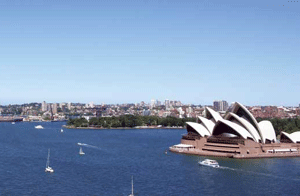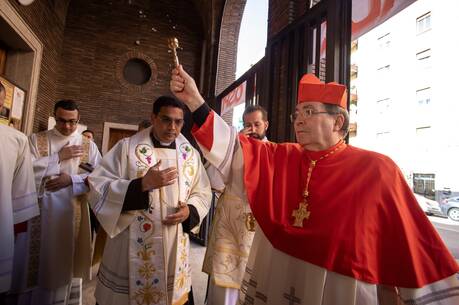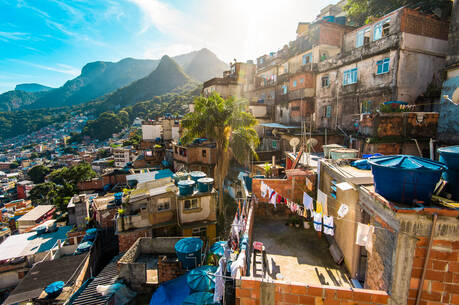Growing up, I never knew much about Australia. I once had a boomerang—never could make it come back. I guess I had seen pictures of kangaroos. That was about it. For me the world extended only as far as my aunts had traveled. In my mind I could see the Tower of London, its hanging chains and flesh-eating crows; I watched players strut about, waxing eloquent on the Globe stage; and I drove a winding road through the green hills of Ireland. But Australia might as well have been Mars.
And so it remained until about a year ago, when I was sent along with 10 other Jesuits from around the world to Sydney, Australia, to begin the final stage of my formal training as a Jesuit. The purpose of the assignment was part seasoning, part renewal. Put down your packs and spend seven months with other young Jesuits, reflect on your lives in the Society and deepen your relationships with God and with his people. The location was in a sense arbitrary; Australia’s program had a great reputation, but there were similar programs for Jesuits all over the world, including several in the United States.
You Have Now Left Kansas
When we arrived in Pymble, a town north of Sydney, in late January of last year, it looked like any affluent American suburb—stately houses, quiet neighborhoods, parks. Our community residence rested on a verdant, wooded piece of property about 20 minutes from the ocean and 30 from Sydney proper. It was once a school where young Australian Jesuits studied theology; today it serves as a retreat house, a retirement community and a home for those who have just entered the Society and also for us. From the walls generations of former residents grinned at us.
It all seemed comparable to what you might find in the States, I thought late that first day, as I sat outside snacking on cookies and wondering if it was going to rain. Then a flock of enormous white cockatoos shot from the trees screaming. Cutting down through the air, they surrounded me like a 1950’s gang of pomaded greasers, their beaks opening and closing greedily as they eyed my treat.
At dinner I could barely follow the conversation, just bits and pieces here and there when the older men slowed down between explosions of sound filled with laughter and madcap energy. As for the food: I discovered that the Australian spread with the dangerous-sounding name Vegemite, which I put on my bread, though it looked like creamy dark chocolate, actually tasted like deep-salted yeast.
As the sun set, a sound like monkeys laughing hysterically came from the trees behind our house.
The States? I don’t think so. Welcome to Oz.
Australia 101
During our first weeks together, the 11 of us and our directors eased in, told stories to one another of the jobs we had done, the ways we had entered the Society, our families. We took it slow, leaving harder things, the more brittle parts of ourselves, for later conversations. We came to find in one another a place of welcome and rest.
Between conversations I burned through Down Under, Bill Bryson’s fascinating travelogue about his adventures through the land, the people and the history of Australia. Australia, it turns out, is a funny combination of old and young. As a landmass it is ancient, much of it worn away to red desert over millions of years. Its first settlers, the Aborigines, arrived by sea between 45,000 and 60,000 years ago, probably from what today we know as the Indonesian archipelago. Their use of boats put them roughly 30,000 years ahead of the rest of the world.
As a nation, though, Australia is quite young. The British first landed a ship here in 1780, roughly three centuries after Columbus arrived in the Americas. When the First Fleet—11 ships consisting of 729 convicts banished to spend the rest of their lives in Australia and 160 marines—landed near Sydney on Jan. 18, 1788, the United States had already become an independent state. Australia’s British colonies federated into their own country in 1901.
Today Australia has a population of 22 million and consists of six states and two territories on a piece of land that is roughly the same size as the continental United States. If you were to lay Australia over the United States, it would stretch horizontally from Los Angeles to Detroit and vertically from Seattle to Mexico City. Yet most people live on its coasts; over 13 million inhabitants (nearly 60 percent) live in and around the coastal capital cities alone.
In describing Australia, Bryson frequently returned to the number of different species here that can kill you. Forget lions and tigers and bears; here live some of the most dangerous spiders and crocodiles and sea creatures in the world. The box jellyfish, for instance, is six to eight inches long and feeds on tiny shrimp, but it is the deadliest creature on the planet. One momentary brush with its venomous tentacles, and you really can’t ever go home again. Near the Great Barrier Reef there are also critters living in cone shells that will poison you if you pick them up. We’re talking about killer seashells!
By the time I finished the book, I was hungry to know more of this world. And I had decided never to go swimming.
Sydney
Our lives in Pymble took on a certain rhythm. We prayed together each morning, our chairs set in a circle around a candle flame. Seminars were held on community life, intimacy, the history and character of the Society of Jesus. We became connoisseurs of food courts, movie houses and the Chatswood Mall. Sydney was just a train ride away; but nestled away comfortably in suburbia in those early months, most of us were hobbits in our holes, content to devour our second breakfasts and enjoy a cup of tea with lunch, some port, a morsel (or two) of dark chocolate and some television after dinner.
Eventually, though, each of us found his way into the city for one reason or another. For me, it was to stand in awe before that seashell, ship’s sail wonder, the Sydney Opera House. I arrived by train on a blue-sky summer’s day, crowds wandering idly up and down Circular Quay. After a short stroll there it was before me, Jørn Utzon’s Pritzker Architecture Prize-winning work, shining white in the sun and looking…well, a little small, actually. But probably that was the shock of being “in the postcard,” rather than looking at it. I walked slowly around the base, waiting for the angle that would bowl me over.
Off to the left, the Harbour Bridge, the world’s widest long-span bridge and tallest arch bridge, bowed across the water, another jewel of Australia. Yet no matter how long I stood there, it, too, did little for me. I went home puzzled at what I could not see.
Occasion brought me back to the Harbour many times: a walk through the Royal Botanic Gardens at dusk, just as bats with the wingspans of jumbo jets threw themselves from branch-swinging slumbers into the air around me; a hilarious evening with classmates drinking beer and eating pizzas topped with kangaroo and crocodile meat; a night out to a play. And with each return I noticed more—the curves and sudden sharp edges of the Opera House; the stately, understated arc and unexpected hues of the bridge; and the majesty of the harbor itself, an astonishing panoply of lovely, unique inlets, bays and beaches that cannot be taken in all at once.
I spent most of one Indian summer afternoon and an evening sitting on a bench on the Harbour Bridge, looking out on a million boats sailing the harbor. Sunset cast the curls of the distant shoreline in reds and yellows and purples, homes in the distance glowing a brilliant pearl white. In the evening the Opera House shone like a jewel surrounded by the myriad twinkling pinpoints of the city lights.
If you ever travel to Australia, come and sit here on a summer’s day.
(Really) Far From the Madding Crowd
After some months together, the 11 of us were sent to parishes and schools to serve as spiritual guides for people interested in making a retreat. Each of us had been asked to consider what sort of location we wanted, not exactly an easy choice when you are in an enormous country and you want to see everything. But the image that came to me was of a stone in hand, thrown as hard and as far as you could—“hucked,” we would have said as kids. No urban setting for me, thank you; fling me wide, as far out as I could go.
I was sent to Cobar, an outback community of about 5,000 people in western New South Wales. Cobar is a mining town 10 hours by bus and train from Sydney; the phrase “back of Bourke,” Australian slang for “the middle of nowhere,” refers to an actual town just two more hours farther on. In the middle of my first week, the parish priest took me to Wilcannia, the next town over. It was a 150-mile drive away. In between, we saw absolutely nothing—no towns, no rest stops, no gas stations, just lots of low brushy trees and hunched birds at the roadside, chewing dead kangaroo.
The parish of St. Lawrence O’Toole, where I worked was a lovely, welcoming community with a grade school where the kids wore broad floppy hats and with parishioners who laughed readily at my bad jokes and the way I said “mate.” Twice each week 10 members of the parish came to talk individually with me about their relationships with God. Supposedly I was there to help, but mostly I watched in awe as God entered into their lives in very specific and individual ways. It was as though God had been waiting for so long to have this time with them.
On my off day each week the parish priest took me into different parts of the area. I had imagined the outback would offer a sprawling landscape of red soil and blue sky stretching as far as the eye could see—like the Badlands of South Dakota, maybe—strange, otherworldly. In fact, the bush chokes the horizon like giant weeds. From the road you cannot see much of anything but the same ugly trees over and over again. At times you almost feel as though you are in a tunnel. And off the road it’s more and more of the same. Stifling, horrible.
Yet with time, absent a view, a focal point and perspective, you become aware that you are within something much bigger than yourself. Perspective, you discover, gives a sense of mastery, of power. Now you are in something you cannot tame.
In the Aboriginal rite of passage known as “walkabout,” as I have read about it, the young man who agrees to wander into the outback for six months goes forward with no clear destination in mind. It is a dangerously foolish plan, considering how inhospitable the environment can be; but being out there one begins to see the sense of it. The whole concept of a path is ridiculous; there are no tracks that lead anywhere, no straight line that will not get bent and bent and bent again by the sameness of the terrain, no way to avoid being lost. The only way to journey in this world is to give yourself over to it and let it happen.
The months that followed brought many other treasures: 30 days spent making the Spiritual Exercises of St. Ignatius in silence, learning to wait for God amid the golden vine-swept hills and burning sunsets of the wine country of South Australia; the full-on, five-senses dining astonishment that is a trucker’s breakfast in the small town of Hay; five brilliant, challenging weeks in Melbourne; soaring eucalyptus trees, tiny purple wildflowers and nights in which I lost myself in black velvet heavens scattered with the whitest of stars.
Most gifts led back to the same: being led into a world I could not navigate, had not imagined, “a sunburnt country,” as the poet Dorothea Mackellar describes Australia, a bewildering land of “beauty and terror,” and finding it to be the face of God.
When the 11 of us finally parted, seven months after we had first met, it was with embraces and even some tears. Who knew when we would next meet one another, if ever? In one another’s company and in this land of Australia, we had found support and God’s grace. Now it was time to pick up our packs and go walkabout again.









During spring break a year ago, I too went on a mini-walkabout down under to escape the concrete jungles of Hong Kong. I had the good fortune to begin my Sydney sojourn at Canisius College retreat house, while the author's tertian class was away. Being the only retreatant signed up that weekend, I was invited to dine with the novice and retired community. The hospitality and fellowship were wonderful and I remain grateful to the Aussie Jebbies who welcomed me and am happy to have this occasion to thank them.
Greetings from Down Under, Australia. Some of us Aussies have been waiting for these words of Jim's - and they were worth waiting for! Jim, and other tertians to come, would be most welcome in Australia. Thank you for being kind to our country and for the service that America Magazine provides to the English-speaking church.
Dear Father Jim..... a great piece.....a beautiful land..... great people. Now you can brighten someone's day....
Father Leo Donnelley, a Columban (Irish) priest from Ballarat, in his early 70's, spent his life in Peru serving the poorest of the poor... and is now retired there........ we were living in Lima when he arrived there in the late 1950's. He visited his homeland this past winter... He is a great lifelong friend... and he is a long way from Ballarat. Why don't you email him at: ledonem@hotmail.com. You know we Irish better stick together............. and Father, please tell the guys at AMERICA to accept some of my articles...... I realize they do not know me, but I know them......... Many thanks, Father...bail o Dhia ort..... que Dios te bendiga............
Vince Hodgins (born in the ould sod, linguist, historian, theologus, writer, former senior Mexican career diplomat.....)
Kissimmee FL 34744-2702